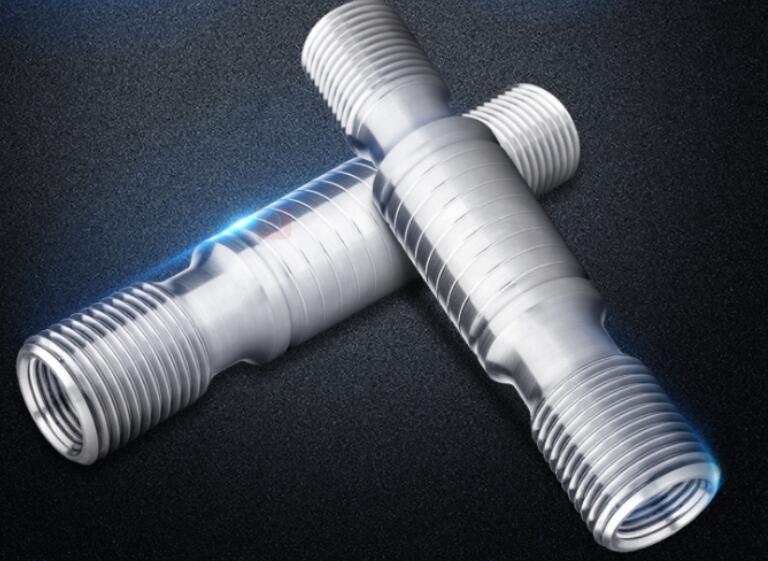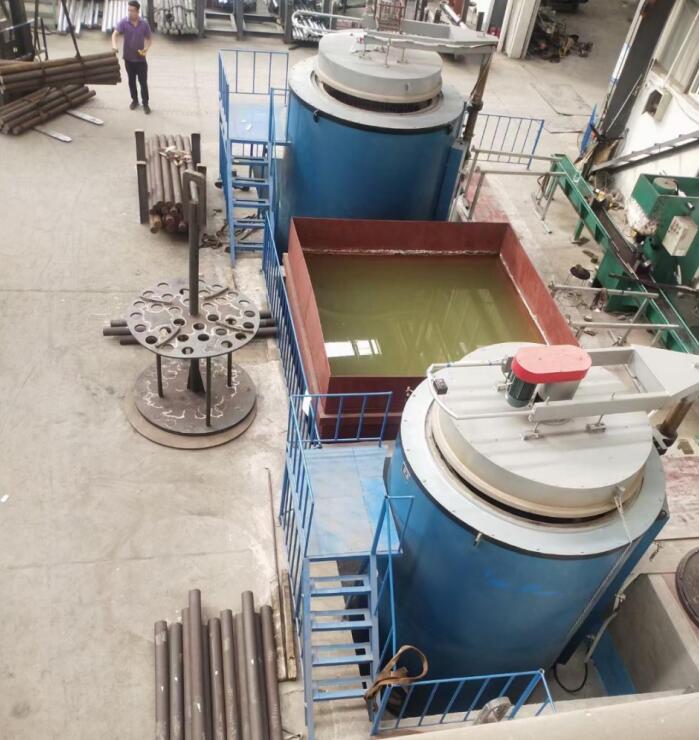Steam Turbine High Temperature Fasteners Bolts Heat Treatment
The effect of heat treatment process on microstructure and mechanical properties of 2Cr12NiMoV steel was studied by Hangzhou Ruiqin Mechanical Equipment Co., Ltd.The results show that the steel can obtain good toughening effect when quenched at 1055 ~ 1070℃ and tempered at 700 ~ 710℃.On this basis, the heat treatment process specification of the steel was determined when it was used to manufacture high temperature fastening bolts for steam turbines.
Key words: 2Cr12NiMoV steel, quenching temperature, impact toughness, high temperature fastening bolt
2Cr12NiMoV steel is 12 %Cr type martensitic stainless heat resistant steel, mainly used in the manufacture of high temperature fasteners for large steam turbines.With the development of large steam turbine and its manufacturing technology, the steel is used more and more in China.However, up to now, there are few reports on the effect of heat treatment system on the microstructure and properties of the steel, which brings a lot of inconvenience to the practical application of the steel.The effects of different heat treatment parameters on the microstructure and mechanical properties (hardness and impact toughness) of 2Cr12NiMoV steel at room temperature were studied.On this basis, the heat treatment process of high temperature fastening bolt of steam turbine made of the steel is optimized.

Test materials and test methods
1.1 Test materials
The test material is taken from the retired steam turbine bolt of a power plant, and its chemical composition (%) is 0.24C, 12.22Cr, 0.62Ni, 0.93Mo, 1.25W, 0.30V, 0.20Si, 0.64Mn, 0.016P, 0.010S.
1.2 Test method
First, the test steel was annealed. The annealing process was heating at 870 ℃ for 3 h, cooling at 20 ℃/h to 700 ℃ for 3 h, and then furnace cooling to 500 ℃ for air cooling.The annealing structure (Fig. 1) shows that granular carbides and a certain amount of grain boundary carbides are distributed on the ferrite matrix.The annealed material is processed into the blank of the impact sample, which is then quenched and tempered at different temperatures, and finally becomes the standard Charpy impact sample of 10 mm×10 mm×55 mm through grinding and wire cutting.
Annealing organization
Quenching heating was carried out using a 4 KW high-temperature pit type heat treatment furnace, and different quenching heating temperatures, such as 950℃, 980℃, 1010℃, 1040℃, 1055℃, 1070℃, 1100℃, 1130℃ and 1160℃, were selected for the test.The quenching and heating time of each sample is 4 min/mm, and the oil is cooled after heating .The oil quenching was processed in the oil quenching tank , Tempering is carried out in a 5 KW pit type tempering furnace. Three tempering temperatures of 650℃, 680℃ and 710 ℃ are selected. The tempering time is 6 h.
The impact toughness of the samples after different heat treatment was determined by impact test at room temperature.Fracture analysis, metallographic analysis and hardness measurement were carried out on the specimen.The etching agent used for metallographic analysis is aqueous nitrate solution of ferric chloride.The austenite grain size was measured by Hilliard method [1], using a corrosive agent of saturated picric acid aqueous solution with a small amount of sodium alkylbenzene sulfonate.
Test results and analysis
2.1 Influence of quenching temperature on austenite grain size
The effect of quenching temperature on the austenite grain size increases with the increase of quenching temperature. When the temperature is lower than 1070 ℃, the grain size tends to be small, and when the temperature is higher than 1070 ℃, the grain size increases.Since the number of undissolved carbide phases directly affects the austenite grain size during quenching and heating, the more undissolved carbide phases, the smaller the austenite grain size [2].Therefore, the data in Table 1 indicate that when the quenching temperature reaches 1070 ℃, most of the carbides in the original structure have dissolved into the austenite, which greatly reduces the obstacles hindering grain boundary migration and accelerates the growth rate of austenite.
Effect of quenching temperature on austenite grain size
Quenching temperature /℃ : 980℃,1040℃,1070℃,1100℃,1130℃,1160℃
Austenite grain size/grade :6.7 6.4 6.2-5.2
2.2 Influence of quenching temperature on hardness and impact toughness
Effect of quenching temperature on impact toughness and hardness at 680 ℃ and 710 ℃ tempering.At the same tempering temperature, the hardness increases continuously with the increase of quenching temperature.This is because with the increase of heating temperature, the amount of alloy carbide dissolved into austenite increases, so that the degree of alloying of austenite and subsequently obtained martensite increases, so as to improve the anti-tempering stability of martensite.The effect of quenching temperature on impact toughness is complex. The impact toughness increases with the quenching temperature increasing, and when the quenching temperature exceeds 1040 ℃, the impact toughness increases obviously.Under the tempering condition of 710 ℃, the impact toughness reaches the maximum when quenching at 1055 ~ 1070 ℃.When quenching above 1100 ℃, impact toughness decreases with the increase of quenching temperature.
(a) 680 ℃;(b) 710 ℃
Quenching metallographic structure
(a) 980 ℃;
(b) 1070 ℃
Metallographic structure of samples at different quenching temperatures.The quenching structure is lath martensite, and the orientation of the lath beam accords with a certain crystal orientation.The size of martensite lath increases with increasing quenching temperature.When quenching at 980 ℃, the grain boundary carbides remain in the quenching structure because of the low quenching temperature. When the quenching temperature is raised to 1055 ~ 1070 ℃, the grain boundary carbides are almost all dissolved in austenite.
2.3 Influence of tempering temperature on impact toughness
Influence of tempering temperature on impact toughness and hardness.In the temperature range of 650 ~ 710 ℃, at the same quenching temperature, the impact toughness increases and the hardness decreases with the tempering temperature increasing.When the tempering temperature is higher than 680℃, the increase of impact toughness and the decrease of hardness increase significantly, indicating that the tempering transition rate is significantly faster than 680℃.Therefore, for 2Cr12NiMoV steel only at a temperature higher than 680℃ tempering, tempering transformation can be more fully carried out to ensure that the tempering structure has enough stability and high toughness.
Effect of tempering temperature on hardness
Fracture analysis
Under the conditions of this test, the micro-fracture morphology of impact samples subjected to different heat treatments is roughly similar, consisting of dimple zone and quasi-cleavage zone (Fig. 6).The fracture analysis shows that there is a good correspondence between the width of the dimple zone and the impact toughness of the specimen. The specimen with a larger width of the dimple zone has a higher impact toughness.However, the specimens with higher toughness have finer tearing edges and smaller tearing units in the quasi cleavage zone.
Heat treatment of fastening bolts at high temperature
High temperature fastening bolt is the key part to ensure the safety of steam turbine.According to the service conditions of the bolt, it is required to conduct tempering and tempering treatment. In order to avoid the brittleness of the bolt during assembly and disassembly, it is required to have high impact toughness at room temperature.The specific technical requirements are Hb 277 ~ 331 and AK > 35 J/cm2 [3].Based on the results of this test, quenching at 1055 ~ 1070 ℃ and tempering at 700 ~ 710 ℃ are selected as the heat treatment process of bolts.Through this process, not only the bolt can be guaranteed to have higher strength and toughness, but also to have a more stable structure in long-term service.After treatment, the hardness of bolts is Hb 287 ~ 299, AK = 40 ~ 62 J/cm2, which meet the requirements of technical conditions.
Discussion:
(1) Under the tempering condition of 710 ℃, the impact toughness increases first and then decreases with the increase of quenching temperature.The analysis of the causes of this phenomenon shows that the grain size of austenite and the degree of dissolution of grain boundary carbides are the main factors affecting the impact toughness of 2Cr12NiMoVv steel quenched and tempered at high temperature.With the increase of quenching temperature, the amount of carbide dissolved increases, especially the grain boundary carbide dissolved into austenite in the annealing structure, so that the binding force between grains increases, thus improving the impact toughness.On the other hand, with the increase of quenching temperature, the austenite grains grow up and the impact toughness decreases.
Fracture morphology of impact sample
(a) The dimple zone;(b) quasi cleavage region
The impact toughness increases with the increase of temperature.When the quenching temperature reaches 1055 ~ 1070 ℃, almost all grain boundary carbides are dissolved into austenite, and the impact toughness reaches the maximum.As the quenching temperature continues to increase, the austenite grain coarsenes, and the latter factor turns to play a dominant role, which reduces the impact toughness obviously .
(2) The quenching temperature range of 2Cr12NiMoV steel recommended in the literature is mostly 980 ~ 1040 ℃ [4.5].According to the results of this test, because there is a considerable amount of grain boundary carbides in the annealing structure of the steel, it is difficult to dissolve a large amount of grain boundary carbides when quenching in the above section, resulting in a low impact toughness at room temperature after quenching and tempering.If the quenching temperature is properly raised to 1055 ~ 1070 ℃, most of the grain boundary carbides have been dissolved and the austenite grains have not been coarsened obviously, and then tempered at an appropriate temperature, a good match of room temperature strength and toughness can be obtained.
Effect of quenching temperature on high temperature properties of 2Cr12NiMoV steel.The results show that with the increase of quenching temperature, the tensile strength (σ570105) increases. After quenching at 980, 1040 and 1100 ℃, and tempering at 680 ℃, the σ570105 is 85.3 MPa, 114.7 MPa and 122.6 MPa, respectively.There is no significant difference between the three quenching temperatures in the extra long ductility, and the elongation (Δ10) is more than 10%.Therefore, appropriately increasing quenching temperature can not only significantly improve the impact toughness at room temperature, but also improve the endurance strength without reducing the endurance ductility.
If the quenching temperature is increased to 1100 ℃, the impact toughness at room temperature is greatly reduced, and the value of lasting strength is also little increased, and because of the austenite grain coarsening, the notch sensitivity of the steel is increased, which is not desirable for high-temperature fastening of the notched parts such as bolts.
To sum up, it is recommended that 2Cr12NiMoV steel be heated and quenched in the temperature range of 1055 ~ 1070 ℃.
Editing by Francis Lee
Copyright: RQ Furnace

Learn More :
Effect of High Energy Ball Milling and Vacuum Annealing on Microwave Properties of Nanocrystalline FeSiAl Carbon Classification Of Carburizing Heat Treatment Cementation, Nitriding And Carbonitriding Process

Contact us
Your email address will not be published. Required fields are marked *